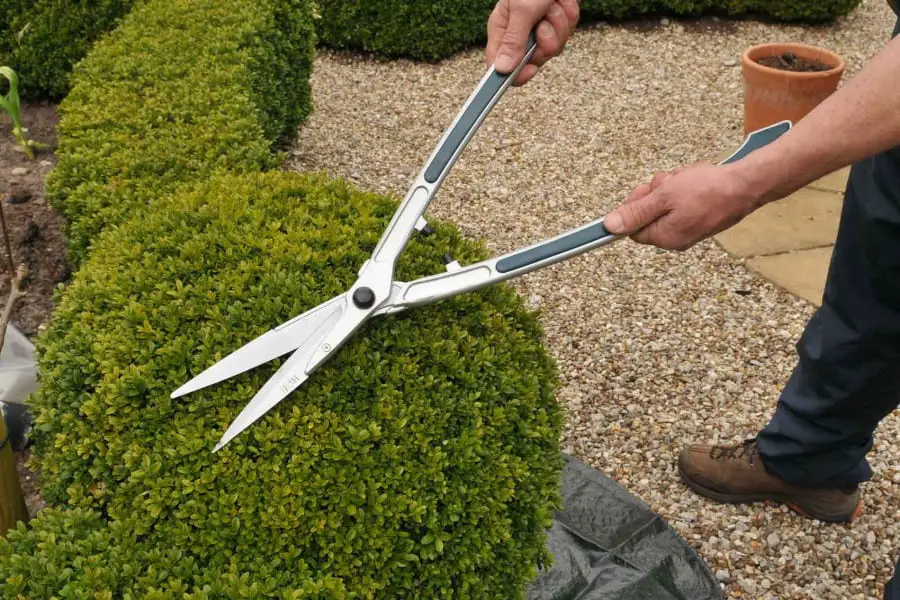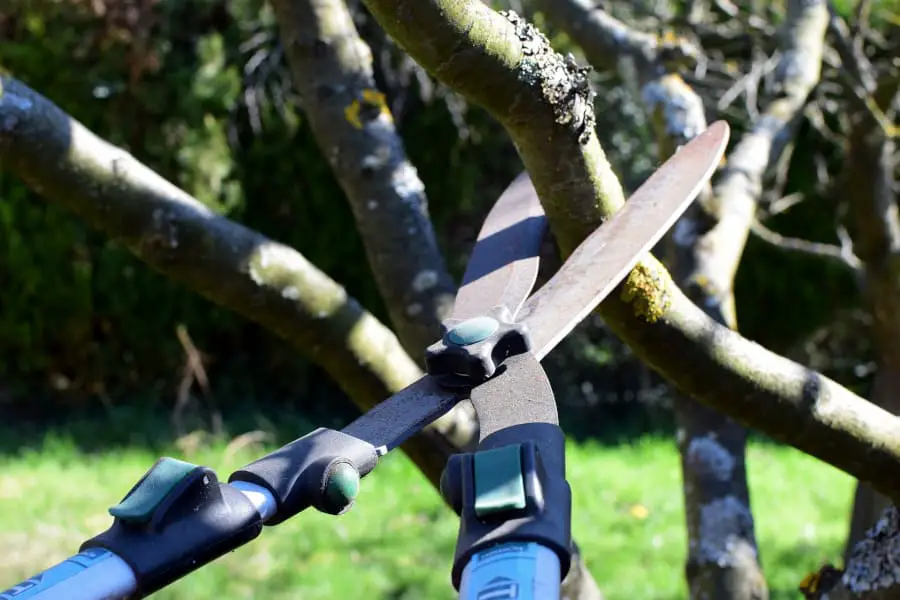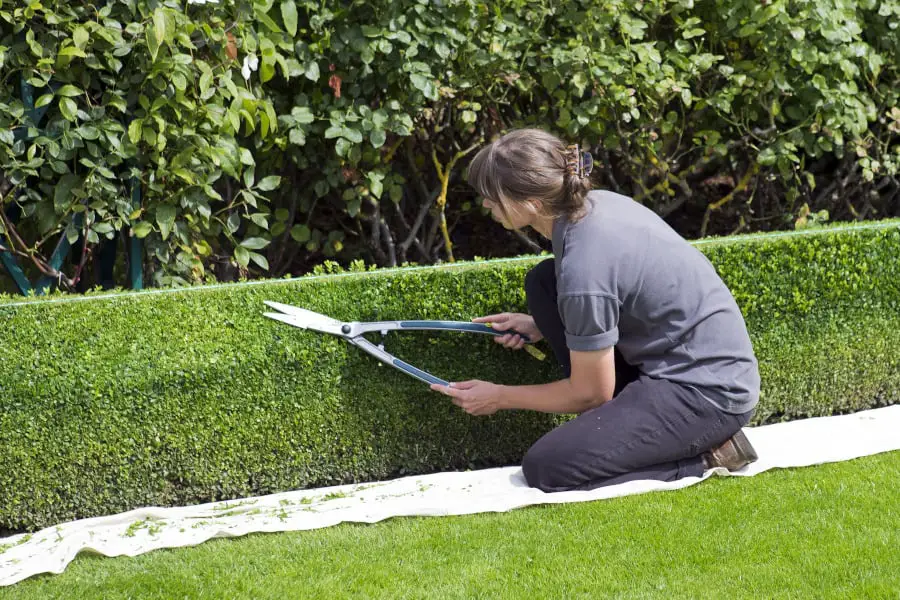Are you an avid gardener looking for tools that would help you maintain the state of your garden? If so, hedge shears come in handy to maintain and make your garden beautiful. Let us walk you through the different uses of hedge shears to help you improve your garden.
8 Most Common Uses of Hedge Shears
Hedge shears are multi-purpose tools used for shaping shrubs and cutting weeds, overgrown grass, bushes, and shrubs. Here, you will find various common uses of hedge shears to help you maintain your garden.
- Cutting Any Small Branches
- Creating and Maintaining a Formal Hedge
- Pruning Branches After Flowering
- Deadheading
- Thinning Shrubs
- Cutting Back Perennials
- Cutting Lawn Edges
- Cutting Thin or Soft Trimmings Smaller for Composting
Cutting Any Small Branches
Pruning tools are invaluable for handling plants and trees in your garden. Hedge shears are pruning tools that help remove long branches or several small branches of a tree simultaneously.
Hedge shears have a blade that is edgy and straight at the cutting surface. They are not suitable for cutting thick branches since that could make their blades go dull faster. They can only cut branches that are ½ inches in thickness.
These tools work well for cutting soft plants, including lilyturf, hostas, catmint, and various other perennials and ornamental grasslands.
Trimming small twigs or branches using a hedge trimmer will provide your garden a neater look, keeping the bushes clutter-free. It also lets you get creative with your plants and create a topiary in the garden. So, with proper usage of hedge shears, you could add aesthetics to your garden.

Creating and Maintaining a Formal Hedge
Hedge shears greatly help create a formal hedge for people who want to give their garden a unique or stylish look. You could impose straight cuts on your plant’s soft growth using hedge shears to create a formal hedge, in which artificial and stylish appearances are preferred.
If you already have a formal hedge, proper use of hedge shears would help you maintain it by getting rid of overgrowth and out-of-place branches. So, you could get the desired look for your garden.
However, it may cut only specific species of plants this way. The purpose of pruning the shrubs is to get a presentable and natural appearance, which does not require straight cutting.
Pruning Branches After Flowering
Pruning involves cutting or trimming long branches of trees that could be dangerous otherwise. The unwanted elements you observe in your garden may cause trouble in the future. These elements might hinder the healthy growth of your plants. Thus, pruning becomes necessary.
To successfully do it, make sure to remove specific parts of a plant, including branches, buds, or roots. Pruning could help you provide your plant a specific shape. This means you can control the direction in which your plant grows.
Usually, gardeners use pruning tools like a hedge shear weekly for trimming and pruning plants. However, there are certain times deemed suitable for using hedge shears. It is best to prune the branches of the trees after flowering takes place.
Avoid making pruning cuts during spring as they might grow back or develop a callus. Besides twigs, you should prune new flowers during the early spring or winter.

Deadheading
Deadheading is a simple way of removing dead flowers from the stem of your plants. It not only helps your plants appear cleaner but allows them to grow thicker and healthier.
Some people hand-prune their plants, but the deadheading of soft and highly fertile plants that grow rapidly would take quite long. Using hedge shears for deadheading your plants would make the process much easier and convenient for you. They allow you to reach inside a plant and make a precise and neat cut with the least damage to the plant.
For instance, vines and non-woody clematis grow so quickly that they conceal unnatural cuts. But with a hedge shear, you could effectively deadhead prolific small-flowering plants like lavender, tickseed, and Santolina.
Thinning Shrubs
A hedge shear could help you cut the branches and water sprouts back to their origin on the stem. This pruning method will lead to a more open plant without causing unnecessary growth.
The thinning shrubs method opens the plant, promoting air circulation that helps reduce diseases and enhances growth. It is mainly used in plants, including lilac, crape myrtle, magnolia, smoke bush, and viburnums.
Avoid shearing them continuously as it may lead to thick growth and diseases. It is better to thin boxwood them once in a while.
Cutting Back Perennials
Some perennials need to be cut back to their heads to protect them from the cold and stimulate growth in the spring. Hedge shears are ideal for cutting soft, dead branch tissues. They can cut soft plants like hostas, catmint, columbine, lilyturf, and other perennial plants.
For instance, the foliage of catmint is damaged during the cold winter. Therefore, it is advisable to cut its foliage in the fall to make cleaning the garden easier in the spring. These plants respond well to trimming done for refreshing and cleaning up the foliage throughout the season.
However, hedge shears may not work with cane plants that require thinning and semi-woody perennials.

Cutting Lawn Edges
A lawn with overgrown edges may appear quite unattractive and make your garden look untidy. To improve your garden’s appearance, you must recut your lawn’s edges every spring and trim large grass after mowing.
A hedge trimmer could come in handy for cutting huge grassy areas and make the task less cumbersome for you. It allows you to efficiently trim down the grass and help you tidy up your lawn. Ensure the trimming area does not have any obstacles like rocks as they may break the hedge shears.
Also, wear safety clothing and tie up your hair while using a hedge trimmer to prevent any kind of inconvenience. It is better to kneel when cutting short grass, keeping the blade parallel to the ground. Be sure not to hit the blade on the ground as it could cause severe damage to the hedge shears.
Cutting Thin or Soft Trimmings Smaller for Composting
The tree pruning, twigs, branches, and stems you cut using hedge shears are appropriate for composting. The hedge clippings can be used for making compost. Anything less than one inch composts well and can be added directly to the compost heap or bin. However, thicker stems or branches are not suitable for the purpose.
Hedge shears are ideal for cutting the branches or prunings into smaller pieces suitable for a compost bin.
Types of Hedge Shears
There are various designs and versions of hedge trimmers, including manual, electric, gas-powered, and telescopic hedge trimmers.
Manual hedge trimmers appear as huge scissors or pruning shears and also come with telescopic handles. They are operated manually; thus, they are quite environment-friendly and affordable.
Motorized hedge trimmers work faster and feature safety devices that enable use only when you place both hands on the handles. Gas-powered trimmers are more powerful, heavyweight, and tricky to operate.
On the contrary, electric trimmers are lighter, less potent, quieter, and environmentally friendly compared to gas-powered tools.
Conclusion
Hopefully, after reading through the different uses of hedge shears, you now know how to effectively use them to trim tree branches and shrubs. It is essential to possess a pruning tool for the proper upkeep of your garden.
Hedge shears are one of the best tools for beautifying your garden and enhancing your plants’ growth. Be mindful of the species of your plants and prioritize pruning based on their growth needs. So, add some aesthetic style to your garden using hedge trimmers!


